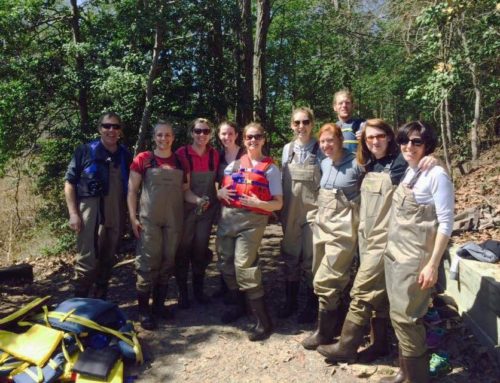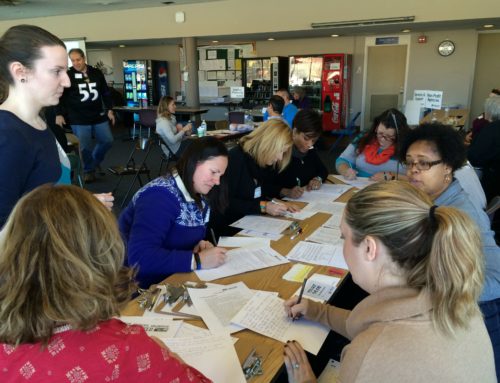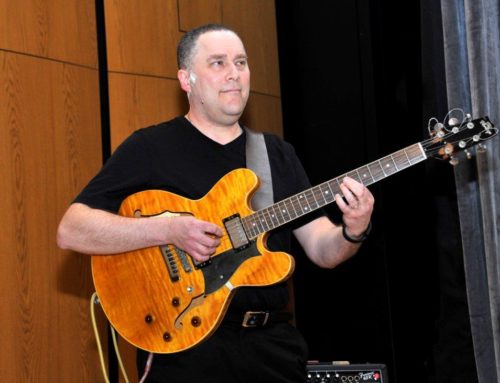Exploring Public Safety and AACPS Instructional Programs
December 5, 2014
It’s probably fair to say that December’s LDI class was the most anticipated session of the course. Focused on public safety, we spent the afternoon in Anne Arundel County’s Correctional Facility at Jennifer Road. Considering that my knowledge of the prison system comes almost solely from Orange is the New Black, I expected the day to be eye-opening. So what took me by surprise was not what I could learn about the place, but rather about the people inside.
Touring the Facility
I arrived at the Jennifer Road Detention Center with the second wave of my class (i.e. the half that underestimated how long it would take to get through traffic) and checked in at the front desk. We traded our IDs for visitor’s badges, locked up our cell phones, and were screened by a metal detector and guard. Once we were registered, two guards led us out of the waiting room. (I want to apologize in advance for not including the names of the guards who accompanied us on our tour. We couldn’t bring our belongings with us and remembering names is not my strong suit). We walked through a thick locked door into a small room with a second door at the other end. We waited while a guard locked the first door closed with a solid clunk. The second guard then unlocked the next door and we filed into the corridor. This logistic detail is small, but I describe it in detail because we followed this procedure over and over again as we moved throughout the facility. Before leaving the office for the evening’s session I spoke with a colleague and alumni of LDI’s first graduating class. He said that when they visited the corrections facility, he felt a small part of himself stay behind each time a door closed and he was right.
We joined the rest of the class in a meeting room where we were greeted by Terry Kokolis, the Department of Correction Facilities Superintendent in charge of the facility on Jennifer Road as well as correctional center at Ordnance Road. Mr. Kokolis gave us an overview of Anne Arundel County’s Department of Detention Facilities’ mission and introduced us to the facility at Jennifer Road. To “provide for public safety,” the Department provides a facility to safely house pretrial and convicted offenders and offers reentry services to help all inmates become productive members of society. The Jennifer Road Detention Center is the county’s maximum security intake and pretrial detention center. It’s current population of 400-450 inmates (men, women, and a few juveniles), are awaiting trial, held because they could not make bail and/or held because they required special housing for behavioral reasons, medical or mental health. Designed to be a more transient facility, Jennifer Road sees approximately 9,000 people come in and out each year. They offer full medical services and recently instituted a GED program which, as of our visit, had graduated approximately 800 people.
After this introduction, our group was joined by other members of the facility’s staff: Michael Borgese, Assistant Correctional Facility Administrator for the Bureau of Security and Support Services, Margo Knight, Assistant Correctional Facility Administrator for the Bureau of Inmate Services, and Brenda Shell-Eleazer, Correctional Facility Administrator (aka Warden). Led in two groups, we had the opportunity to tour the facility. Moving from one locked room to the next, we saw all major components of the building including the visitor’s area (which looked exactly as pop culture had led me to believe it would), the men’s cells (sets of common rooms connecting to shared cells, separated down the hallway based on required level of security) and the segregation area (what would have historically be called “Solitary Confinement,” this was a set of rooms with solid–rather than barred–doors around a shared common space).
What stood out most was how intrusive I felt during the tour. There was never a moment when I did not feel entirely safe. In addition to being escorted by a guard, with the exception of a few vocal inmates, everyone we passed was either friendly and polite or, more often, apathetic towards us. But regardless of the reason an inmate was in that building, for as long as they were there, this was their home and we were traipsing through it. We never entered an occupied cell (which would house 4-8 inmates), but when we walked through a common area we knew from the looks we received that we were in someone else’s space.
A Panel of Inmates
The most powerful part of the experience was after we returned to the meeting room and had the opportunity to talk to a panel of inmates. The six men, all of whom volunteered to meet with us, ranged in age from barely 20 to mid-30s, grew up in this county, and all went to an AACPS high school. Each person introduced themselves and gave a painfully honest account of how they ended up there. Their crimes ranged from dealing drugs to armed robbery to breaking and entering. Everyone there had struggled or was struggling with substance abuse and came, in one way or another, from a broken home. For some, this was their first conviction; for others, this was the third or fourth time at Jennifer Road. Several of the men were fathers and all spoke with conviction about how “this would be the last time;” that they were now clean and this would be their last arrest.
Through the hour-long conversation that followed, what we tried to understand what we, as members of the school system, could do to help prevent our students today from being on the other side of that table tomorrow. Anyone in education would tell you that this question is unbelievably complicated, but we got a simple answer: “Let them know that you care.” Several members of the panel shared stories about how difficult it was to be engaged in school given the homes they went back to each night. Across the group, some had grown up in poverty, some had working single-parents who were not around much, and some had parents who had their own addictions and had completely checked out. But when they came into the school, they often felt like no one understood or, even worse, that no one cared. One inmate said that even though he struggled through class, couldn’t keep up his grades, and was often absent, no one ever asked him what was going on at home. He didn’t feel like he had anyone that he could turn to and told us that kids need someone that they know they can lean on. When they can’t get that at home, they need someone at school who can be willing to step up and help.
This wasn’t true for everyone, however. Doris addressed this question to one of the members of the panel in particular who she actually knew as a former student. (This was a possibility that Griff had prepared us for–over the past five years that Griff has been bringing LDI to this facility, there is almost always one person on the panel who had a personal connection to someone in the LDI class). She told him that she remembered working with him; that his teachers, his counselor, and the principal worked with him to help him graduate. He had that support, she said, so what happened? It was clear that this question was hard to answer. He knew the school did their best, but it was ultimately influences outside of the building that led him down this path. He had begun smoking marijuana while he was in high school and after he graduated he moved onto harder drugs. Eventually he stole to pay for his addiction and that was how he was arrested. What would have help, he said, was to have seen earlier where addiction leads. Almost everyone on the panel agreed that having the chance to talk to someone in the system would have made them realize how important it is to stay out. Several inmates asked us about opportunities for them to help talk to students who were “headed down the wrong path.”
Through these candid responses we were reminded of an important fact—that each person sitting behind that table was there because of something that they did. No one tried to make excuses and each clearly explained what they had done wrong to land behind those bars. It was not our fault that they were there and no one educator had failed them in a way that directly led to them being arrested. But that did not mean that we, as a system, could not have done more to help.
We have a responsibility to understand our students, to ask why they are struggling, and to provide resources to not only get them through school, but to be successful in life. In some cases, this may mean tailoring our expectations to fit what each individual child wants to achieve. Every student will not go to college, but every student has the potential to become a happy and productive member of society. It is our job to make sure that they know that.
Before they left, Pat thanked every person on that panel. In summarizing what I believe to be everyone’s thoughts, he thanked them for having the courage to talk to us. They have so much to give, he said, and he hoped that they could take that passion and use it to do good. As hard as we try, no one person can ever reach every child. But as a system, what we can do is improve the way we reach out to our students, offer greater and more equitable access to opportunities and resources, and let everyone of our 80,000 students know that we care.






